Pan Liu
CHIMERE
CheXWorld: Exploring Image World Modeling for Radiograph Representation Learning
Apr 18, 2025Abstract:Humans can develop internal world models that encode common sense knowledge, telling them how the world works and predicting the consequences of their actions. This concept has emerged as a promising direction for establishing general-purpose machine-learning models in recent preliminary works, e.g., for visual representation learning. In this paper, we present CheXWorld, the first effort towards a self-supervised world model for radiographic images. Specifically, our work develops a unified framework that simultaneously models three aspects of medical knowledge essential for qualified radiologists, including 1) local anatomical structures describing the fine-grained characteristics of local tissues (e.g., architectures, shapes, and textures); 2) global anatomical layouts describing the global organization of the human body (e.g., layouts of organs and skeletons); and 3) domain variations that encourage CheXWorld to model the transitions across different appearance domains of radiographs (e.g., varying clarity, contrast, and exposure caused by collecting radiographs from different hospitals, devices, or patients). Empirically, we design tailored qualitative and quantitative analyses, revealing that CheXWorld successfully captures these three dimensions of medical knowledge. Furthermore, transfer learning experiments across eight medical image classification and segmentation benchmarks showcase that CheXWorld significantly outperforms existing SSL methods and large-scale medical foundation models. Code & pre-trained models are available at https://github.com/LeapLabTHU/CheXWorld.
EchoWorld: Learning Motion-Aware World Models for Echocardiography Probe Guidance
Apr 17, 2025Abstract:Echocardiography is crucial for cardiovascular disease detection but relies heavily on experienced sonographers. Echocardiography probe guidance systems, which provide real-time movement instructions for acquiring standard plane images, offer a promising solution for AI-assisted or fully autonomous scanning. However, developing effective machine learning models for this task remains challenging, as they must grasp heart anatomy and the intricate interplay between probe motion and visual signals. To address this, we present EchoWorld, a motion-aware world modeling framework for probe guidance that encodes anatomical knowledge and motion-induced visual dynamics, while effectively leveraging past visual-motion sequences to enhance guidance precision. EchoWorld employs a pre-training strategy inspired by world modeling principles, where the model predicts masked anatomical regions and simulates the visual outcomes of probe adjustments. Built upon this pre-trained model, we introduce a motion-aware attention mechanism in the fine-tuning stage that effectively integrates historical visual-motion data, enabling precise and adaptive probe guidance. Trained on more than one million ultrasound images from over 200 routine scans, EchoWorld effectively captures key echocardiographic knowledge, as validated by qualitative analysis. Moreover, our method significantly reduces guidance errors compared to existing visual backbones and guidance frameworks, excelling in both single-frame and sequential evaluation protocols. Code is available at https://github.com/LeapLabTHU/EchoWorld.
Non-Destructive Detection of Sub-Micron Imperceptible Scratches On Laser Chips Based On Consistent Texture Entropy Recursive Optimization Semi-Supervised Network
Mar 17, 2025



Abstract:Laser chips, the core components of semiconductor lasers, are extensively utilized in various industries, showing great potential for future application. Smoothness emitting surfaces are crucial in chip production, as even imperceptible scratches can significantly degrade performance and lifespan, thus impeding production efficiency and yield. Therefore, non-destructively detecting these imperceptible scratches on the emitting surfaces is essential for enhancing yield and reducing costs. These sub-micron level scratches, barely visible against the background, are extremely difficult to detect with conventional methods, compounded by a lack of labeled datasets. To address this challenge, this paper introduces TexRecNet, a consistent texture entropy recursive optimization semi-supervised network. The network, based on a recursive optimization architecture, iteratively improves the detection accuracy of imperceptible scratch edges, using outputs from previous cycles to inform subsequent inputs and guide the network's positional encoding. It also introduces image texture entropy, utilizing a substantial amount of unlabeled data to expand the training set while maintaining training signal reliability. Ultimately, by analyzing the inconsistency of the network output sequences obtained during the recursive process, a semi-supervised training strategy with recursive consistency constraints is proposed, using outputs from the recursive process for non-destructive signal augmentation and consistently optimizes the loss function for efficient end-to-end training. Experimental results show that this method, utilizing a substantial amount of unsupervised data, achieves 75.6% accuracy and 74.8% recall in detecting imperceptible scratches, an 8.5% and 33.6% improvement over conventional Unet, enhancing quality control in laser chips.
NsBM-GAT: A Non-stationary Block Maximum and Graph Attention Framework for General Traffic Crash Risk Prediction
Mar 06, 2025



Abstract:Accurate prediction of traffic crash risks for individual vehicles is essential for enhancing vehicle safety. While significant attention has been given to traffic crash risk prediction, existing studies face two main challenges: First, due to the scarcity of individual vehicle data before crashes, most models rely on hypothetical scenarios deemed dangerous by researchers. This raises doubts about their applicability to actual pre-crash conditions. Second, some crash risk prediction frameworks were learned from dashcam videos. Although such videos capture the pre-crash behavior of individual vehicles, they often lack critical information about the movements of surrounding vehicles. However, the interaction between a vehicle and its surrounding vehicles is highly influential in crash occurrences. To overcome these challenges, we propose a novel non-stationary extreme value theory (EVT), where the covariate function is optimized in a nonlinear fashion using a graph attention network. The EVT component incorporates the stochastic nature of crashes through probability distribution, which enhances model interpretability. Notably, the nonlinear covariate function enables the model to capture the interactive behavior between the target vehicle and its multiple surrounding vehicles, facilitating crash risk prediction across different driving tasks. We train and test our model using 100 sets of vehicle trajectory data before real crashes, collected via drones over three years from merging and weaving segments. We demonstrate that our model successfully learns micro-level precursors of crashes and fits a more accurate distribution with the aid of the nonlinear covariate function. Our experiments on the testing dataset show that the proposed model outperforms existing models by providing more accurate predictions for both rear-end and sideswipe crashes simultaneously.
Analyzable Parameters Dominated Vehicle Platoon Dynamics Modeling and Analysis: A Physics-Encoded Deep Learning Approach
Feb 09, 2025Abstract:Recently, artificial intelligence (AI)-enabled nonlinear vehicle platoon dynamics modeling plays a crucial role in predicting and optimizing the interactions between vehicles. Existing efforts lack the extraction and capture of vehicle behavior interaction features at the platoon scale. More importantly, maintaining high modeling accuracy without losing physical analyzability remains to be solved. To this end, this paper proposes a novel physics-encoded deep learning network, named PeMTFLN, to model the nonlinear vehicle platoon dynamics. Specifically, an analyzable parameters encoded computational graph (APeCG) is designed to guide the platoon to respond to the driving behavior of the lead vehicle while ensuring local stability. Besides, a multi-scale trajectory feature learning network (MTFLN) is constructed to capture platoon following patterns and infer the physical parameters required for APeCG from trajectory data. The human-driven vehicle trajectory datasets (HIGHSIM) were used to train the proposed PeMTFLN. The trajectories prediction experiments show that PeMTFLN exhibits superior compared to the baseline models in terms of predictive accuracy in speed and gap. The stability analysis result shows that the physical parameters in APeCG is able to reproduce the platoon stability in real-world condition. In simulation experiments, PeMTFLN performs low inference error in platoon trajectories generation. Moreover, PeMTFLN also accurately reproduces ground-truth safety statistics. The code of proposed PeMTFLN is open source.
Generating Physically Realistic and Directable Human Motions from Multi-Modal Inputs
Feb 08, 2025Abstract:This work focuses on generating realistic, physically-based human behaviors from multi-modal inputs, which may only partially specify the desired motion. For example, the input may come from a VR controller providing arm motion and body velocity, partial key-point animation, computer vision applied to videos, or even higher-level motion goals. This requires a versatile low-level humanoid controller that can handle such sparse, under-specified guidance, seamlessly switch between skills, and recover from failures. Current approaches for learning humanoid controllers from demonstration data capture some of these characteristics, but none achieve them all. To this end, we introduce the Masked Humanoid Controller (MHC), a novel approach that applies multi-objective imitation learning on augmented and selectively masked motion demonstrations. The training methodology results in an MHC that exhibits the key capabilities of catch-up to out-of-sync input commands, combining elements from multiple motion sequences, and completing unspecified parts of motions from sparse multimodal input. We demonstrate these key capabilities for an MHC learned over a dataset of 87 diverse skills and showcase different multi-modal use cases, including integration with planning frameworks to highlight MHC's ability to solve new user-defined tasks without any finetuning.
A Joint Representation Using Continuous and Discrete Features for Cardiovascular Diseases Risk Prediction on Chest CT Scans
Oct 24, 2024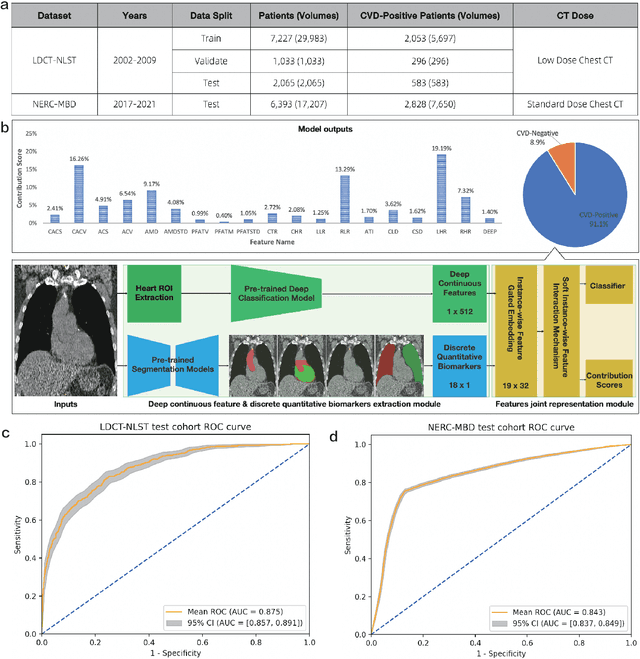



Abstract:Cardiovascular diseases (CVD) remain a leading health concern and contribute significantly to global mortality rates. While clinical advancements have led to a decline in CVD mortality, accurately identifying individuals who could benefit from preventive interventions remains an unsolved challenge in preventive cardiology. Current CVD risk prediction models, recommended by guidelines, are based on limited traditional risk factors or use CT imaging to acquire quantitative biomarkers, and still have limitations in predictive accuracy and applicability. On the other hand, end-to-end trained CVD risk prediction methods leveraging deep learning on CT images often fail to provide transparent and explainable decision grounds for assisting physicians. In this work, we proposed a novel joint representation that integrates discrete quantitative biomarkers and continuous deep features extracted from chest CT scans. Our approach initiated with a deep CVD risk classification model by capturing comprehensive continuous deep learning features while jointly obtaining currently clinical-established quantitative biomarkers via segmentation models. In the feature joint representation stage, we use an instance-wise feature-gated mechanism to align the continuous and discrete features, followed by a soft instance-wise feature interaction mechanism fostering independent and effective feature interaction for the final CVD risk prediction. Our method substantially improves CVD risk predictive performance and offers individual contribution analysis of each biomarker, which is important in assisting physicians' decision-making processes. We validated our method on a public chest low-dose CT dataset and a private external chest standard-dose CT patient cohort of 17,207 CT volumes from 6,393 unique subjects, and demonstrated superior predictive performance, achieving AUCs of 0.875 and 0.843, respectively.
Metasurface-based Snapshot Shortwave-Infrared Hyperspectral Image Reconstruction with Inter and Intra Prior Learning Network
Jul 11, 2024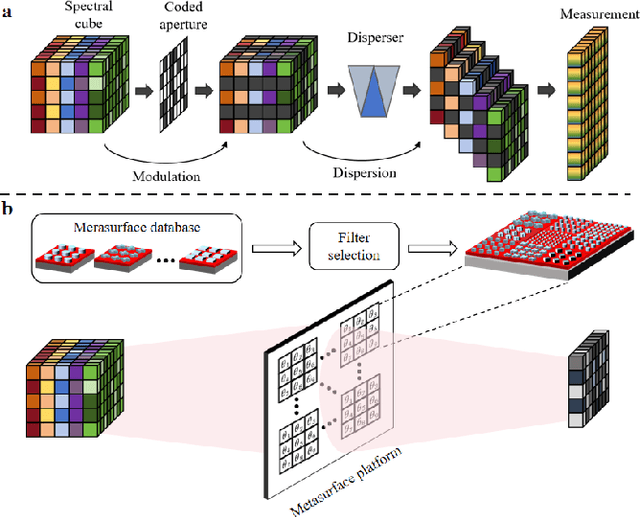
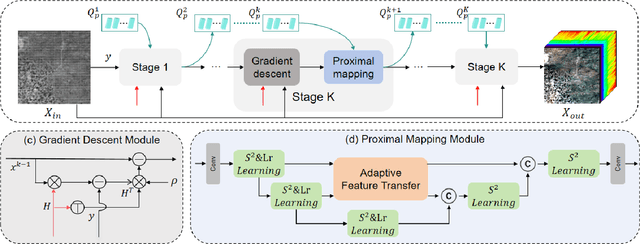
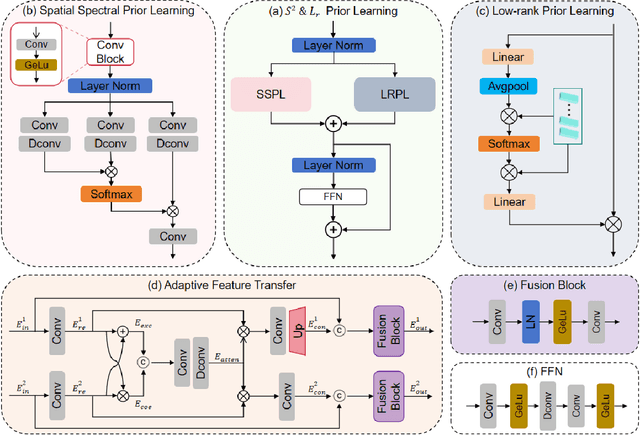
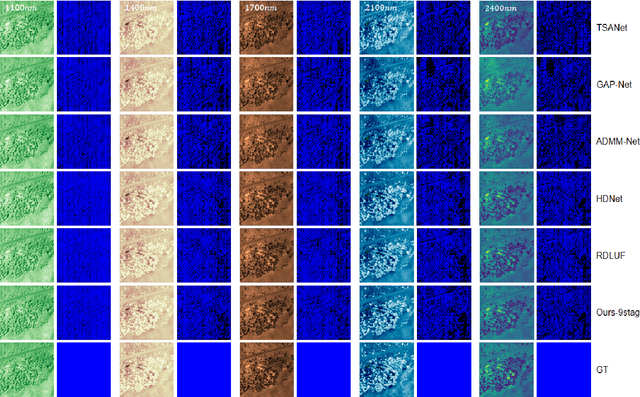
Abstract:Shortwave-infrared(SWIR) spectral information,ranging from 1 {\mu}m to 2.5{\mu}m, breaks the limitations of traditional color cameras in acquiring scene information and has been used in many fields. However, conventional SWIR hyperspectral imaging systems face challenges due to their bulky setups and low acquisition speed. In this work, we introduce a snapshot SWIR hyperspectral imaging system based on a metasurface filter and a corresponding filter selection method to achieve the lowest correlation coefficient among these filters.This systemhas the advantages of small size and snapshot imaging. We propose a novel inter and intra prior learning unfolding framework proposed to achieve high-quality SWIR hyperspectral image reconstruction, which bridges the gap between prior learning and cross-stage information interaction. We also design an adaptive feature transfer mechanism to adaptively the transfer contextual correlation of multi-scale encoder features to prevent detailed information loss in the decoder. Experiment results demonstrate that our method can reconstruct HSI with high speed and superior performance over existing methods.
AceMap: Knowledge Discovery through Academic Graph
Mar 05, 2024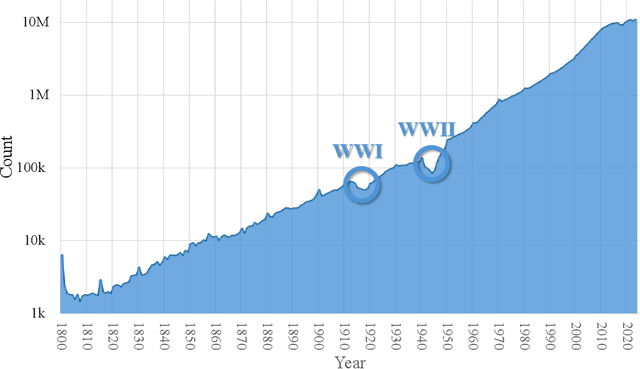
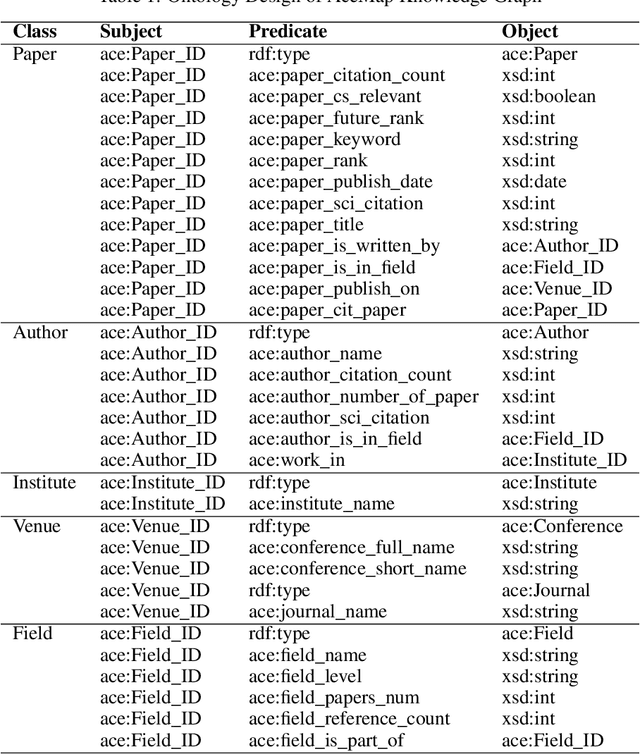

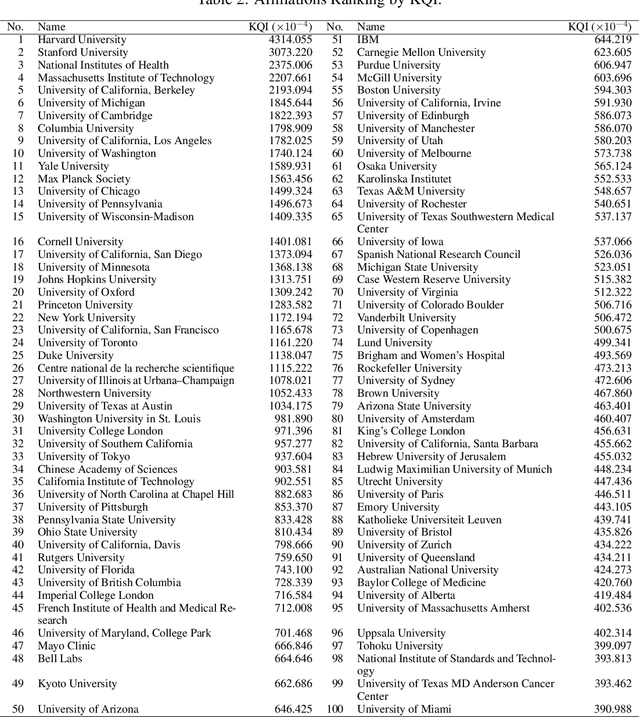
Abstract:The exponential growth of scientific literature requires effective management and extraction of valuable insights. While existing scientific search engines excel at delivering search results based on relational databases, they often neglect the analysis of collaborations between scientific entities and the evolution of ideas, as well as the in-depth analysis of content within scientific publications. The representation of heterogeneous graphs and the effective measurement, analysis, and mining of such graphs pose significant challenges. To address these challenges, we present AceMap, an academic system designed for knowledge discovery through academic graph. We present advanced database construction techniques to build the comprehensive AceMap database with large-scale academic publications that contain rich visual, textual, and numerical information. AceMap also employs innovative visualization, quantification, and analysis methods to explore associations and logical relationships among academic entities. AceMap introduces large-scale academic network visualization techniques centered on nebular graphs, providing a comprehensive view of academic networks from multiple perspectives. In addition, AceMap proposes a unified metric based on structural entropy to quantitatively measure the knowledge content of different academic entities. Moreover, AceMap provides advanced analysis capabilities, including tracing the evolution of academic ideas through citation relationships and concept co-occurrence, and generating concise summaries informed by this evolutionary process. In addition, AceMap uses machine reading methods to generate potential new ideas at the intersection of different fields. Exploring the integration of large language models and knowledge graphs is a promising direction for future research in idea evolution. Please visit \url{https://www.acemap.info} for further exploration.
Accuracy of Real-Time Echo-Planar Imaging Phase Contrast MRI
Jul 28, 2022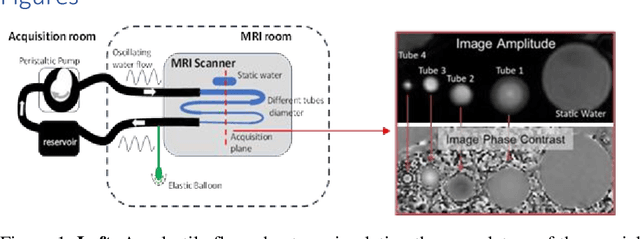
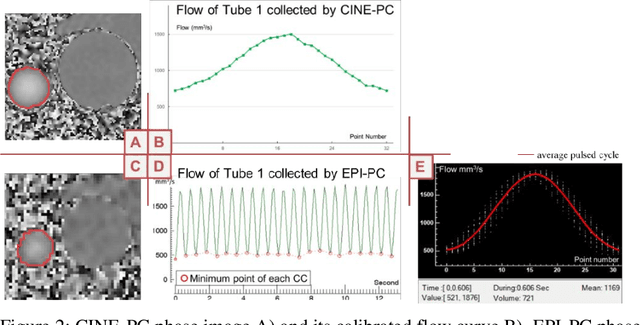
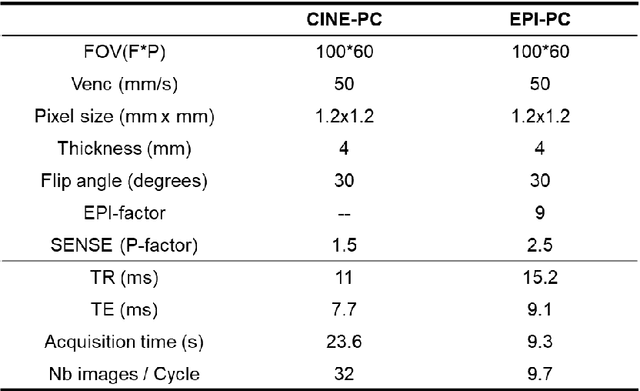
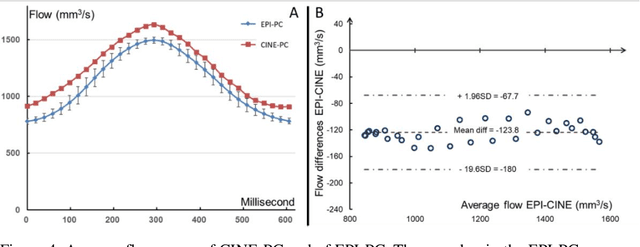
Abstract:Compared with CINE phase contrast MRI (CINE-PC), echo-planar imaging phase contrast (EPI-PC) can achieve realtime quantification of blood flow, with lower SNR. In this study, the pulsating real model of the simulated cerebral vasculature was used to verify the accuracy of EPI-PC. The imaging time of EPI-PC was 62ms/image at 100*60 spatial resolution. The reconstructed EPI-PC flow curve was extracted by homemade post-processing software. After comparison with the CINE-PC flow curve, it was concluded that EPI-PC can provide an average flow with less than 3% error, and its flow curve will be similar to the CINE-PC flow curve in shape.
 Add to Chrome
Add to Chrome Add to Firefox
Add to Firefox Add to Edge
Add to Edge